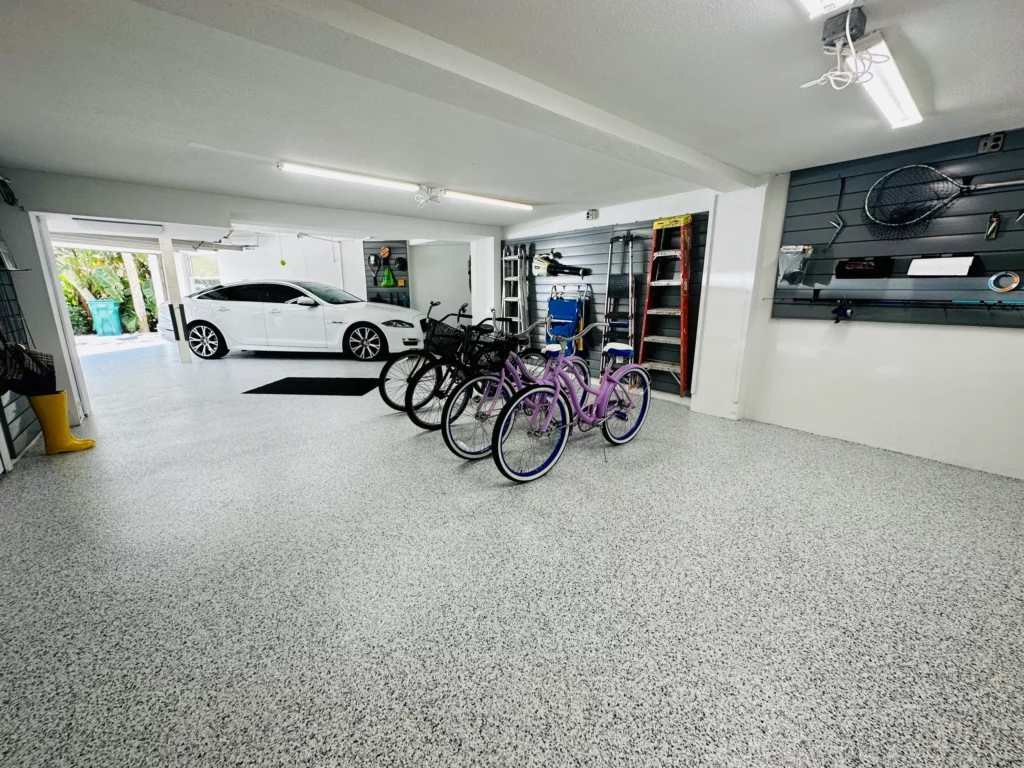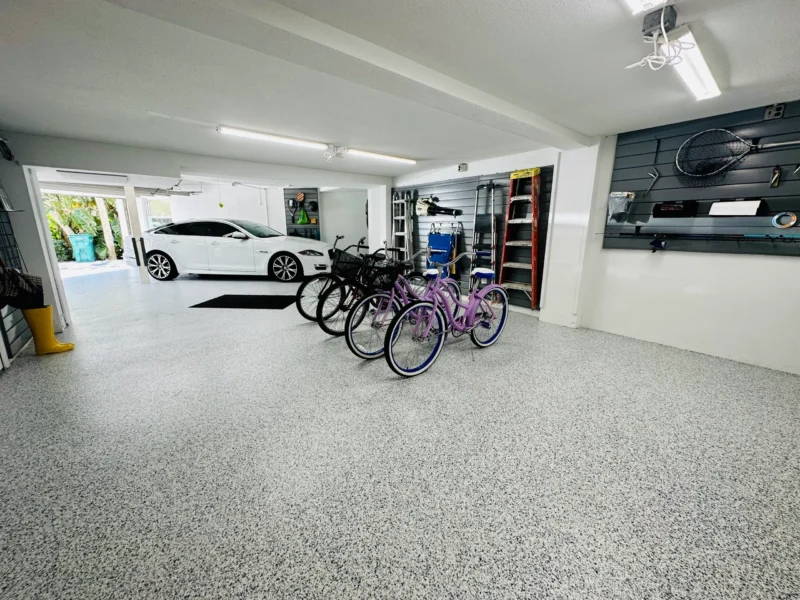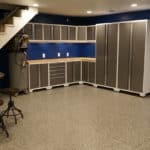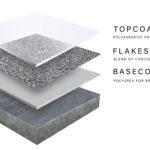
Did you know that a new garage floor coating gives most homeowners the feeling they have a new room in their home? People don’t think of their garage in any other way than just a place to park their vehicles, store their tools, and stack the storage bins which contain their Christmas decorations and the stuff they don’t want in their living room any longer. It could be so much more…
In Michigan and other northern states, some homeowners have totally transformed their garage to make them true living spaces, a spot where the family can congregate on a Sunday afternoon to picnic, watch football, or just kick back with friends around a beer or two.
Yes, with a little bit of a imagination and vision, your garage could fulfill all these roles: the parking space, the storage space, the family space, even the man-case space. You just have to make a few key decisions, organize the clutter, and get the family involved in creating this “everyone’s new space”.
The first key decision most families have to make is to get a new garage floor coating. A garage floor is rarely pretty. It is rarely inviting. Most often, it’s kind of greasy, messy, dirty. Its surface is uneven, sometimes it’s badly pitted. But once you take care of it with a proper coating, it becomes just fabulous.
Garage Floor Coating: What Options Do You Have?
In the many years we have been in business creating new garage floors, we have learned a few good lessons. (a) If your garage concrete floor is full of cracks and holes, it will make the space feel smaller than it actually is. (b) If you fix the concrete and you coat it with a light color, the space will open up and feel visually bigger. (c) When the surface is perfectly even and has a sheen to it, it gives you the sensation of being really clean.
There are 5 main flooring options for your garage. Let’s discuss each one.
1 – Polished Concrete Floor
A polished concrete floor is very versatile, durable, and low maintenance. Your contractor can polish the concrete to a high sheen and give your garage a sleek, modern look.
Why use a contractor, why not DIYing it?
4 reasons not to DIY
- Equipment: Professional concrete grinders and polishers cost thousands of dollars ($3,000-$10,000+ depending on the machine). Rentals are available, but they are still several hundred dollars per day. These machines are extremely heavy (100-200+ lbs) and require significant physical strength and skill to maneuver smoothly. If you are inexperienced, you will easily create waves, divots, uneven patches… and the result will be ugly.
- Technical know-how: Polishing concrete requires multiple passes with increasingly fine diamond-embedded pads (typically 5-8 steps from coarse to fine). Skip a grit level or use the wrong sequence, and you’ll get scratches, swirl marks, or an inconsistent finish that’s nearly impossible to correct. Moving the machine too fast leaves the surface rough; moving it too slow or applying uneven pressure creates low spots and burn marks. Finally, getting smooth, consistent results along walls and in corners requires specialized edge grinders (that you need to rent). Most DIYers end up with obvious differences between the main floor and edges.
- Surface issues: Professional contractors know how to “read” concrete—identify weak spots, determine if the slab is too soft or too hard, spot issues like delamination or improper curing that could ruin the polishing process. Most people don’t have the training to do this. Also, if you grind too deep trying to get a polished look, you may wind up exposing too much aggregate (the stones in the concrete mix), which would create an inconsistent appearance, and even compromise the structural integrity of a thin concrete slab.
- Health issues: Concrete grinding creates dangerous silica dust that can cause serious lung disease. Professionals use industrial dust extraction systems; DIY dust masks aren’t adequate protection for extended exposure.
Considering the cost and the risks involved, there is no benefit in DIYing this job. Hire an experienced contractor, and kick back while they are sweating hard.
Polished Concrete Floor Design Examples
Similar to what a new garage floor coating brings to your home, polished concrete gives you a large design versatility. Are you going for the industrial-chic aesthetic? Leave the concrete in its natural gray tone with a high-gloss finish that reflects light beautifully. Do you prefer warmer tones? Acid-stained concrete creates rich browns, terra-cottas, or amber hues that add depth and character to the floor.
You can even customize the floor with geometric patterns scored into the concrete before the polishing job. This creates distinct “zones”: parking, workbench, storage, man-cave… There is also a design option consisting in applying a subtle metallic additive that gives the floor a sophisticated shimmer. You can combine different stain colors to create a “faux-marble” effect or incorporate your favorite team’s colors for a personalized sports-themed space.
2 – Epoxy Garage Floor
Laying down an epoxy coat is a great option to refurbish and update a garage floor. the new garage floor coating will be glossy. The hard finish of epoxy will hide blemishes and imperfections on the surface of the concrete.
There are two main epoxy formulations: self-leveling and broadcast. With self-leveling epoxy, the contractor pours a coating over the floor and smoothes it out. With broadcast epoxy, the contractor proceeds in two coats: the first coat is a primer, the second is the color coat.
Epoxy is resistant to most spills and stains. An epoxy garage floor is a good option if you have a workbench and you work on mechanical projects. It is also an appropriate option if your children play in this new family space. Another advantage of epoxy is that it is easy to clean with a broom and a mop.
The main disadvantages of epoxy in the situation of a garage are its sensitivity to UV rays (with a light yellowing over time), and its sensitivity to temperature shocks. Warm tires can leave dark marks on an epoxy garage floor. This can be remedied with color flakes. They hide these tire marks and add a bit of textured grip to the epoxy, making it less slippery.
Epoxy Garage Floor Design Examples
Epoxy flooring opens up a world of creative possibilities. A popular option consists in broadcasting decorative color flakes or chips into the epoxy base coat. A subtle gray and white blend will result in a granite-like appearance. Multicolor combinations will hide dirt and tire marks. Metallic epoxy systems create stunning, three-dimensional effects that mimic flowing water, molten metal, or swirling marble. You can pick colors ranging from copper and bronze to silver and pearl. A note of caution: you may eventually get tired of very strong colors and visual effects. Based on customer experience and feedback, the best long-term options are neutral colors.
Epoxy lends itself to designing complex patterns on the floor: checkerboards in contrasting colors (the classic black and white of course, but also blue and yellow, black and yellow, red and white, or the colors of the flag… Color patterns can help define “zones” in the garage. Some people use racing stripes, others incorporate their family crest, a business logo, or a favorite cartoon/movie character directly into the epoxy.
3 – Polyurea/Polyaspartic Garage Floor
If you’re researching options for a new garage floor coating, you may have come across polyurea and polyaspartic coatings—often marketed as “the next generation beyond epoxy.” While these new materials are often mentioned in the same sentence as epoxy, they are a different coating technology that addresses many of the known limitations of epoxy.
For instance, a polyaspartic coating (used a topcoat over a polyurea base coat) is UV-stable: it won’t yellow or fade in sunlight. Both materials are also more flexible than epoxy, which makes them less prone to cracking as your concrete expands and contracts with temperature changes. They both offer superior chemical resistance to gasoline, oil, and corrosive automotive fluids.
The drawback of these new coating materials is their cost, 50% to 100% more expensive than epoxy. Also, they can’t be installed by non-professionals because of their fast-setting properties. Like epoxy, they require heavy preparation work of the concrete surface, both for evenness of the final aspect and for adherence of the base coat.
Polyurea Garage Floor Design Examples
Just like for epoxy, it is possible to broadcast decorative colored flakes into a polyurea/polyaspartic coating that has not yet set in. The technique creates a speckled appearance that camouflages dirt, dust, tire marks, and minor imperfections. It keeps your garage looking cleaner longer. The texture provides good slip resistance.
Customize the look of your new garage floor coating by choosing flake size (small, medium, or large), coverage density (light to full broadcast), and color combinations (subtle earth tones, bold multicolor, or even custom blends). Neutral tones add visual interest without being overwhelming.
MotorCity Floors and Coatings recommends polyurea/polyaspartic coatings over epoxy. We will install your new garage floor coating in just one day.
3 – Vinyl Flooring
Vinyl flooring is one of the most cost-efficient flooring options. It is easy to install once you get the hang of working with a stretchable material like vinyl. There are also plenty of colors and styles available off the shelf.
Note however that vinyl flooring is less durable and more difficult to keep clean than other options on our list because of its porosity. Then again, planks can be replaced. Vinyl is also not appropriate in the area where you will park your car, and if you foresee a lot of foot traffic in your garage, it may not be the best option for you. Lastly, the material can be slippery.
Vinyl Floor Design Examples
Modern vinyl flooring has evolved far beyond basic tiles. Specialized stores now offer a full array of design options that help you extend your home interior into your garage. Over the past few years, we have seen a huge enthusiasm for Luxury Vinyl Planks (LVP) that mimic hardwood. With its realistic oak, maple, or reclaimed barn wood look, LVP is great if you convert part of your garage into a home office or a workshop.
For a more contemporary look, check out large-format vinyl tiles that replicate natural stone like slate, travertine, or limestone, complete with authentic texture and color variation.
If you are into geometric patterns, hexagonal tiles can create eye-catching honeycomb designs. Diamond or herringbone patterns add a degree of sophistication. If you’re going for an industrial aesthetic, there are concrete-look vinyl tiles which look a bit like polished concrete without the sheen. For child-friendly spaces, vinyl with printed patterns (subtle speckles, marbling) will help camouflage scuffs and stains.
4 – Stone Flooring
Stone flooring is the high-end look option for your garage. It is definitely the most expensive of the options on this list, but it can be worth the investment. Stone flooring is durable and will last for decades with proper care. It gives your garage a luxurious look.
However, stones are porous by nature. Even granite, the densest of all stones, has a slight porosity score which can be brought down by polishing it. If your car leak oil or other fluids, that will definitely create a problem for the tiles under. Tires can also bring in harsh chemicals in your garage that will leave marks on your tiles or slabs.
Stone Flooring Design Examples
Stone flooring makes a statement. Its appearance elevates your garage to luxury status with a timeless elegance that few other materials can match. The question is which stone, and what form?
Slate tiles can have a rich charcoal color or multi-toned earth colors. They bring natural beauty to your floor and offer excellent slip resistance. However, slate can break in layers, so it may not necessarily be the right choice to park your cars but a good choice for walking and playing areas.
Granite tiles offer extreme durability and come in a spectrum of colors from classic black and gray to blues, greens, even reds. Polished granite has a mirror-like sheen that feels really right for high-end car collections. A honed finish creates better traction, however.
Do not use travertine in high traffic and parking areas of your garage: its porous texture will stain quickly. But it is a beautiful stone with warm beige to ivory tones, that would do well in a man-cave.
Large-format porcelain tiles that mimic marble, with dramatic veining (Calacatta or Carrara styles) are a possible option. They are used in showrooms to showcase vehicles. You can also use them as custom borders and medallion inlays. Use contrasting stone colors to define parking spaces or work areas. These tiles will add an artisanal, unique touch to your garage.
Storage Space
Once your new garage floor coating is done, it’s time to roll out the other parts of your vision. Let’s continue with storage, because storage is a primary function in a garage.
When you create storage space you maximize the use of your garage as a living space. Looking at the ceilings and walls: can you install shelves, cabinets, hooks? Can also use the space above your garage door to store bikes, tools, or luggage? Ceiling-mounted storage metal racks, typically suspended 2-4 feet below the ceiling can hold 300 to 600+ pounds. Use this new space to store seasonal items, camping gear, holiday decorations, and storage bins you don’t need frequent access to.
Slatwall panels and aluminum track systems accept interchangeable hooks, baskets, shelves, and specialized holders. Unlike fixed shelving, these are modular systems you can reconfigure as needs change. Slatwall panels (horizontal grooved panels) and track systems (horizontal rails) can cover entire walls and hold surprising weight (50-75 pounds per square foot when properly installed). They are well-suited for tools, sports equipment, garden supplies, and anything else you want off the floor but within easy reach.
Modular garage cabinet systems are a common storage solution. They come in various materials: from affordable melamine and metal to premium hardwood or stainless steel. Base cabinets with countertops create functional workspaces. Wall-mounted cabinets keep items at eye level. Use deeper cabinets to store power tools, automotive supplies, and chemicals safely away from children.
Pegboards are useful to organize smaller items: small tools, gardening supplies, etc. They are more adapted than slatwalls for small tools and shop supplies used at your workbench.
Lighting
Lighting is one of the most overlooked fixtures in a garage. Most garages are lit with ugly fluorescent lights, sometimes a central LED fixture. The workbench may have a task light. These lighting systems ignore the potential to modulate the garage space in zones and never make you feel good. On the contrary.
You need to rethink your lighting system based on the activities you plan to have in this new space. Let’s imagine a zone system with layers of lighting.
General Ambient Lighting
Install 4-foot or 8-foot LED shop lights (4000-5000 lumens each) across the ceiling in a grid pattern, spacing them 6-8 feet apart. Choose 4000K-5000K color temperature (neutral to cool white) for bright, clear visibility throughout the space. These provide your base layer of illumination for general movement and overall atmosphere. You could have color LEDs with an app to change the color depending on the mood you want to create.
Workbench Task Lighting
Mount a dedicated 4-foot LED shop light (3000-4000 lumens) directly above and slightly forward of your workbench, approximately 24-30 inches above the work surface. This eliminates shadows when you work and provides concentrated light exactly where you need it. Alternatively, use LED strip lights mounted under a wall cabinet or shelf above the workbench for shadow-free illumination.
Central Parking Area Lighting
The central parking area is covered by your general ambient lighting grid, but you could add one central high-output fixture (6000-8000 lumens) if your garage is particularly large or has a high ceiling. Position it directly over the center of the parking space. This ensures adequate light for car maintenance, washing, and detailed inspection.
Storage Space Lighting (Cabinets and Slatwalls)
Install battery-powered or plug-in motion-activated LED strip lights inside your storage cabinets (under shelves or along the top inside edge) and underneath wall-mounted cabinets above slatwall systems. These can automatically illuminate when you open cabinet doors or reach for items on the slatwall. Choose warm white (3000K) for a softer look inside storage areas. You can also stick with neutral white for consistency.
For slatwall areas without overhead cabinets, mount small LED strip lights or track lights along the top edge of the slatwall panels, angled downward to highlight tools and equipment. This creates both functional visibility and an attractive display effect.
Children’s Playground Area Lighting
Create a fun atmosphere in the children’s play zone with dedicated lighting differentiated from the workshop/parking areas. Install a simple track lighting system with 3-4 adjustable heads that can be directed toward the play area. Or use standard ceiling fixtures with smart LED bulbs emitting warm white light (2700K-3000K) for a softer, more inviting feel.
Consider color-changing smart bulbs (controlled via app or remote) that can shift to fun colors during playtime but return to practical white light when needed. This makes the space feel more playful and less industrial. You can also add a simple plug-in floor lamp or wall-mounted swing-arm lamp for softer accent lighting during quieter activities like reading or crafts.
Can MotorCity help you with some of this transformation?
MotorCity Floors & Coatings is a concrete floor coating specialist operating in Novi, MI and across the entire Metro Detroit area. We have installed hundreds of epoxy and polyurea garage floor coatings, and our customers love our work. They gave us a 4.9 rating in Google Reviews. and an A+ rating with the BBB in Novi, MI. We recommend installing polyurea/polyaspartic garage floor coatings: durability, aesthetics, UV resistance, shock and motion adaptability, ease of clean-up, low maintenance requirements… These are the advantages of this type of coatings. Call our technicians at (248) 613-5888 to discuss your project and get an estimate.





